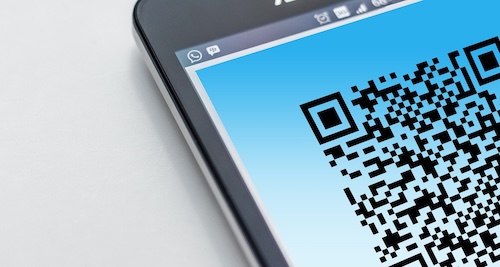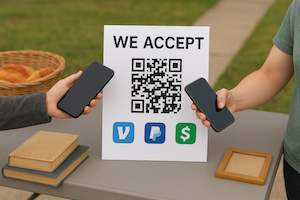How to Accept Digital Payments at a One-Time Yard Sale (and Skip the Cash)
If you’re planning a yard sale but would rather not deal with piles of coins, bills, and the hassle of making change, there’s a modern alternative that makes the process smoother for everyone: digital payments.
With a few minutes of setup, you can easily accept money through popular smartphone payment apps or even take card payments using a simple reader. This guide will walk you through everything you need to know, from choosing the right tools to printing QR codes and ensuring everything runs smoothly on sale day.

Why Offer Digital Payments at Your Yard Sale
Cash has long been the default for yard sales, but it’s no longer the only convenient option. More people than ever rely on digital payment apps, and offering these methods can increase your potential sales and reduce the stress of handling cash.
Providing buyers with multiple payment options helps in several ways:
- Increased convenience: Many shoppers simply don’t carry much cash anymore. Allowing them to pay digitally means you won’t miss out on potential sales.
- Less hassle: You won’t need to stockpile small bills and coins or worry about running out of change.
- Added security: Digital transactions reduce the risk of theft, miscounted cash, or counterfit bills.
- Faster transactions: Buyers can pay and go without waiting for you to count change.
Digital payments are especially helpful for higher-priced items where you can have more flexibily to haggle.
Step 1: Choose and Set Up Your Payment Accounts
Before your sale, choose which digital payment services you want to offer. Most people are familiar with at least one of these options:
Each platform has its own setup process, but they all follow a similar pattern:
- Create an account: Download the app or visit the website to sign up.
- Link your bank account: Transfer funds instantly (for a small fee) or within one to three business days for free.
- Create a payment link or QR code: PayPal uses PayPal.Me links, Venmo and Cash App use usernames or built-in QR codes, and Square provides a card reader option.
Complete all setup steps at least a week before your sale to ensure your bank verification is complete and your accounts are ready to receive funds.
Step 2: Create and Print QR Codes for Easy Payments
QR codes make digital payments effortless. Shoppers simply open their phone’s camera, scan the code, and send the payment directly to your account.
Option 1: Use Built-In QR Codes
Venmo, Cash App, and PayPal all include QR code features within their apps. Open your profile, locate the “QR Code” or “Share” button, and display or print your code for buyers to scan.
Option 2: Generate a Custom QR Code
If you’d like one sign with all your payment options, use a free online QR code generator. Paste each payment link, download the images, and print them on a single, clearly labeled page. Protect it with lamination or a clear sleeve if you’ll be outdoors.
Step 3: Accepting Credit and Debit Card Payments
If you want to go a step further and accept physical cards, you can do so easily through Square or PayPal’s card readers.
Using Square
- Sign up for a free account at squareup.com.
- Link your bank account (allow five business days for verification).
- Order a Square card reader (currently $10) that plugs into your smartphone.
- Download the Square app and log in.
- Enter the sale amount, swipe or tap the buyer’s card, and have them sign on your screen.
Square typically charges a small per-transaction fee (around 2.6% + $0.10). Funds deposit automatically into your linked account.
Using PayPal
PayPal lets you accept payments using either a QR code or a card reader.
To use QR codes:
- Download the PayPal app and sign in.
- Select the QR Code option to generate your personal code.
- Print and display the code for customers to scan.
To use a PayPal card reader:
- Connect your PayPal card reader to your smartphone.
- Swipe or tap the customer’s card to process payment instantly.
PayPal charges small fees on “goods and services” transactions. Payments marked “friends and family” avoid fees but remove buyer protection.
Step 4: Understand Fees and Set Expectations
Different payment methods handle fees differently. It’s important to know what to expect and communicate that clearly with buyers.
- Venmo and Cash App: Usually free for standard transfers; instant cash-outs may include a small fee.
- PayPal: Charges a fee for card-based or “goods and services” transactions.
- Square and other readers: Typically charge a small per-transaction fee (around 2.6% + $0.10).
“We accept Venmo and Cash App (no fee). Card payments via Square include a small processing fee.”
This kind of sign sets expectations and helps buyers choose their preferred payment method easily.
Step 5: Prepare Your Hardware and Connection
- Fully charge your phone before the sale and bring a portable charger.
- Test your internet connection at the sale location. If it’s weak, use a mobile hotspot.
- Keep cash available for backup.
- Use Square’s offline mode if needed, payments will process once you reconnect.
Step 6: How to Handle Payments During the Sale
- The buyer selects their items and asks for the total.
- You tell them the price and direct them to your QR code sign.
- The buyer scans and sends payment.
- You verify the payment in your app before handing over items.
Always confirm the transaction on your device. Do not rely on screenshots or verbal assurances that payment was sent.
Step 7: Keep Transactions Secure
- Confirm payments in real time. Wait for the notification or view the transaction in your app.
- Adjust privacy settings. For example, make Venmo payments private to avoid displaying transaction notes publicly.
- Use usernames or QR codes on your signs instead of personal contact information.
Step 8: Prepare Before and During the Sale
Before the Sale
- Create and verify your payment accounts.
- Link your bank and allow time for verification.
- Test a small payment with a friend.
- Print and label QR codes clearly.
- Charge your phone and bring a backup battery.
- Check your network signal at the sale location.
- Keep cash available as backup.
- Coordinate payment tracking if it’s a multi-family sale.
During the Sale
- Display QR codes and fees clearly.
- Verify each transaction before completing a sale.
- Keep any cash secured or hidden.
Why Going Cash-Free is Worth It
Running a mostly cash-free yard sale is simple, secure, and efficient. Digital payment tools can help you reach more buyers, reduce cash-handling risks, and speed up checkout. With a little preparation and a few printed QR codes, you can run your sale smoothly and confidently, no cash box required.


